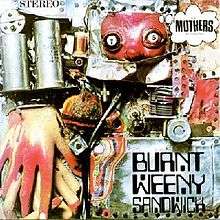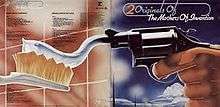Burnt Weeny Sandwich
Burnt Weeny Sandwich is the sixth studio album by the American rock band the Mothers of Invention, and the ninth overall by Frank Zappa, released in 1970. It consists of both studio recordings and live elements.[1][2][3][4] In contrast to the next album Weasels Ripped My Flesh, which is predominantly live and song-oriented, most of Burnt Weeny Sandwich focuses on studio recordings and tightly arranged compositions.
| Burnt Weeny Sandwich | ||||
|---|---|---|---|---|
 | ||||
| Studio album by | ||||
| Released | February 9, 1970 | |||
| Recorded | August 1967 – July 1969 | |||
| Genre | Jazz fusion, progressive rock, avant-rock | |||
| Length | 41:27 | |||
| Label | Bizarre/Reprise | |||
| Producer | Frank Zappa | |||
| Frank Zappa chronology | ||||
| ||||
| The Mothers of Invention chronology | ||||
| ||||
| Singles from Burnt Weeny Sandwich | ||||
| ||||
| 2 Originals of the Mothers of Invention | ||||
 | ||||
| Review scores | |
|---|---|
| Source | Rating |
| Allmusic | |
The LP included a large triple-folded black and white poster ("The Mothers of Invention Sincerely Regret to Inform You") which has never been reproduced in any of the CD reissues.
Title
The album's unusual title, Zappa would later say in an interview, comes from an actual snack that he enjoyed eating, consisting of a burnt Hebrew National hot dog sandwiched between two pieces of bread with mustard.
Burnt Weeny Sandwich and Weasels Ripped My Flesh were also reissued together on vinyl as 2 Originals of the Mothers of Invention, with the original covers used as the left and right sides of the inner spread, and the front cover depicting a pistol shooting toothpaste onto a toothbrush.
Album information
The album was essentially a 'posthumous' Mothers release having been released after Frank Zappa dissolved the band.[5]
Ian Underwood's contributions are significant on this album. The album, like its counterpart Weasels Ripped My Flesh, comprises tracks from the Mothers vault that were not previously released. Whereas Weasels mostly showcases the Mothers in a live setting, much of Burnt Weeny Sandwich features studio work and structured Zappa compositions, like the centerpiece of the album, "The Little House I Used to Live In", which consists of several movements and employs compound meters such as 11/8 with overlaid melodies in 6/8 and 4/4.[6]
The guitar solo portion of the "Theme from Burnt Weeny Sandwich" is an outtake from an unused extended version of "Lonely Little Girl" from the 1967 sessions for the We're Only in It for the Money LP. Zappa and Art Tripp later added multiple percussion overdubs for the released version (The source recordings for the percussion overdubs were issued in 2012 on the posthumous Zappa release Finer Moments under the title "Enigmas 1-5").
"Valarie" was originally intended to be released as a single coupled with "My Guitar Wants to Kill Your Mama". However, either Zappa or his label, Reprise Records, cancelled its release, resulting in its inclusion on the LP.
"Igor's Boogie" is a reference to a major Zappa influence, composer Igor Stravinsky.[7]
Cal Schenkel has noted that his unique cover art for Burnt Weeny Sandwich was originally commissioned for the cover of an Eric Dolphy release.
The piano introduction of "Little House I Used to Live in" appears in Yvar Mikhashoff's four CD set "Yvar Mikhashoff's Panorama of American Piano Music".[8]
The song title for "Little House I Used To Live In" was changed to "The Little House I Used To Live In" on all CD reissues.
Track listing
All tracks are written by Frank Zappa except where noted.
| No. | Title | Length |
|---|---|---|
| 1. | "WPLJ" (The Four Deuces) | 3:02 |
| 2. | "Igor's Boogie, Phase One" | 0:40 |
| 3. | "Overture to a Holiday in Berlin" | 1:29 |
| 4. | "Theme from Burnt Weeny Sandwich" | 4:35 |
| 5. | "Igor's Boogie, Phase Two" | 0:35 |
| 6. | "Holiday in Berlin, Full Blown" | 6:27 |
| 7. | "Aybe Sea" | 2:45 |
| No. | Title | Length |
|---|---|---|
| 8. | "Little House I Used to Live in" | [9]18:42 |
| 9. | "Valarie" (Jackie and the Starlites) | 3:14 |
Personnel
- Frank Zappa – guitar, organ, vocals
- Jimmy Carl Black – percussion, drums
- Roy Estrada – bass, backing vocals, Pachuco rap on "WPLJ"
- Janet Ferguson – backing vocals on "WPLJ"
- Bunk Gardner – wind
- Buzz Gardner - trumpet
- Billy Mundi – drums (uncredited, left group in December 1967, pictured on gatefold cover and possibly played on "Theme from Burnt Weeny Sandwich")
- Lowell George – guitar, vocals
- Don "Sugarcane" Harris – violin on "The Little House I Used to Live In"
- Don Preston – piano, keyboards
- Jim Sherwood – wind
- Art Tripp – drums, percussion
- Ian Underwood – piano, keyboards, wind
- John Balkin – bass on "WPLJ", string bass on "Overture to a Holiday in Berlin"
Production
- Producer: Frank Zappa
- Engineer: Dick Kunc
- Arranger: Frank Zappa
- Design: John Williams
- Cover art: Cal Schenkel
- CD package design: Ferenc Dobronyl
- CD art adaptation: Cal Schenkel
Charts
Album - Billboard (United States)
| Year | Chart | Position |
|---|---|---|
| 1970 | Billboard 200 | 94 |
References
- Allmusic review
- Lowe, Kelly Fisher (2007). The Words and Music of Frank Zappa. ISBN 978-0803260054.
- Ben Watson; Esther Leslie, eds. (2005). Academy Zappa: Proceedings of the First International Conference of Esemplastic Zappology (ICE-Z). ISBN 9780946719792.
- James, Billy (2002-10-01). Necessity Is: The Early Years of Frank Zappa and the Mothers of Invention. ISBN 9780946719518.
- James, Billy (2002). Necessity Is . . .: The Early Years of Frank Zappa and the Mothers of Invention (2nd ed.). SAF Publishing Ltd. p. 133. ISBN 0-946719-51-9. Extract of page 133
- "Song Review by François Couture". All Music. Retrieved 28 June 2014.
- Watson, Ben (1994). Frank Zappa: The Negative Dialectics of Poodle Play. Quartet Books Ltd. p. 9. ISBN 0-7043-7066-2.
- "Yvar Mikhashoff's Panorama of American Piano Music". Mode Records. Retrieved 14 February 2014.
- Length of "Little House I Used to Live in" is incorrectly listed as 21:52 on the sleeve of the original LP and the 2012 CD.